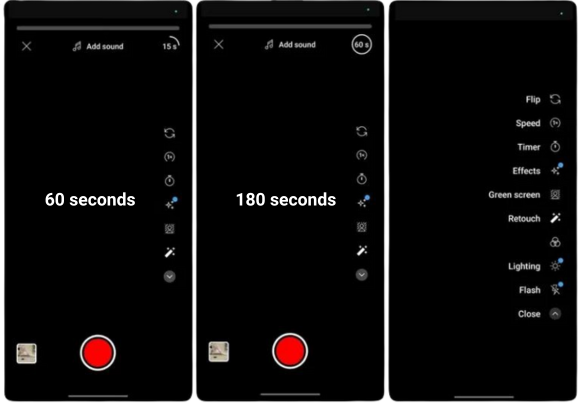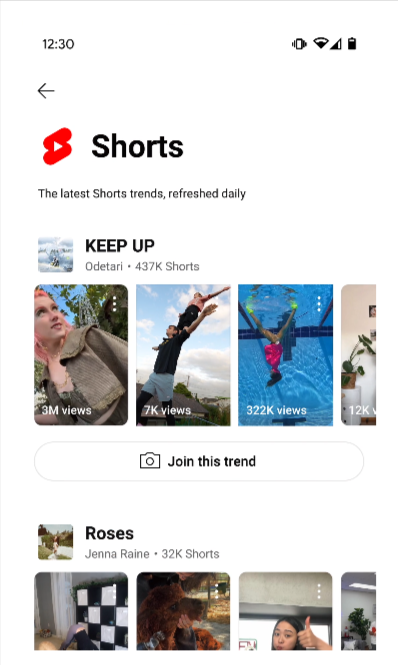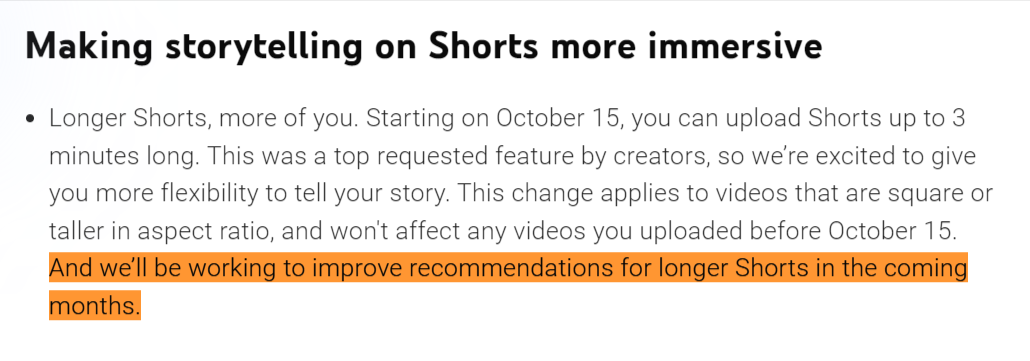YouTube Shorts, the short-form video platform, just received a big update: starting October 15th, 2024, Shorts videos can be up to 3 minutes long. This update could change the short-form video game, especially considering the potential TikTok ban in 2025.
Both platforms allow users to create short-form videos designed to be quick and engaging.
Alphabet, YouTube’s parent company, is likely positioning YouTube Shorts to grab TikTok’s audience, aiming to become the leader in vertical video content if TikTok really does get axed. With all these changes, it begs the question—YouTube Shorts vs. TikTok: Which one will come out on top in 2025? Is YouTube laying the groundwork now to fill the power vacuum left over by TikTok’s seeming demise?
Let’s take a look at what’s happening and what it means for content creators and brands alike.
TABLE OF CONTENTS:
YouTube Shorts vs TikTok: What’s Changing and What It Implies
The most obvious change here is the duration of YouTube Shorts, moving from a maximum of 1 minute to 3 minutes. You could almost say we’ve entered a new season of “long, short videos.” or “short-ish long form videos?” You get the idea.
Beginning October 15, 2024, you can upload YouTube Shorts up to 3 minutes in length.
For creators, this presents new opportunities for longer and more engaging short-form content. However, this update doesn’t necessarily mean things will get easier (or harder) for content creators.
YouTube’s recent blog post hinted that while they’re excellent at recommending short-form videos up to 60 seconds, they’re still perfecting recommendations for videos up to 3 minutes. This means that videos between 1:01 and 3 minutes might struggle for visibility at first—something to keep in mind before jumping headfirst into longer Shorts content.

Competing with TikTok: Is YouTube Positioned to Win?
Perhaps the most amusing detail of this update is its timing.
TikTok already faces a possible shutdown in certain regions during 2025, and Alphabet is clearly preparing for an opportunity to grab more of the vertical video real estate if that happens. When TikTok was banned in India back in 2020, roughly 200 million TikTok users migrated to Instagram and YouTube. Alphabet appears to be strategizing based on this precedent, positioning YouTube Shorts to attract similar audiences if TikTok faces further regional bans, particularly in the U.S.
YouTube has made major strides, like introducing trending searches to connect users to live trends—a feature that feels very TikTok-esque.
The addition of searchable trends gives YouTube Shorts an edge it didn’t previously have.
This integration with the broader YouTube ecosystem enhances content discoverability and caters to a diverse audience.

It’s a smart play to attract TikTok’s audience, who have long been used to a more trend-focused browsing experience. YouTube’s extensive user base already has a rich variety of content, and integrating trending searches into Shorts could mean capturing TikTok’s viral moments and bringing them to a broader platform.
The big takeaway here is that, if TikTok goes away, YouTube is the strongest contender to fill the void left by TikTok. Even if TikTok isn’t shut down in 2025, it will still face a lot of competitive pressure from YouTube as it continues to encroach on TikTok’s user base.
Boost Short-Form Video Reach
Short-form Content Strategy: Where YouTube Shorts and TikTok Videos Differ
Creators need to be mindful of a few major differences when planning short-form video content for these platforms. TikTok has a solid algorithm that excels at promoting viral trends and user engagement with creative tools like filters and music.
In contrast, YouTube’s broader ecosystem of short and long form content allows for a different kind of engagement that intermixes users’ appetite for different modes of content, all in one platform.
While TikTok users may come for the bite-sized content and stay for hours scrolling through video after video, YouTube’s structure includes both YouTube Shorts and traditional videos. This makes YouTube a more integrated space for creators who want their audiences to explore their longer content too.
Here’s our summary of the key differences between the two platforms:
Algorithm and Discovery
- TikTok’s algorithm quickly promotes viral trends and individual content pieces, keeping users engaged for hours.
- YouTube Shorts leverages YouTube’s existing recommendation system, which helps integrate short-form content with traditional, longer videos.
Content Ecosystem
TikTok and YouTube Shorts are both built around bite-sized, fast-paced content that encourages users to keep scrolling. However, YouTube Shorts also exist within a broader YouTube environment, allowing viewers to easily transition from short to long-form content, creating opportunities for deeper audience engagement. And now, it’s blurring the lines even further by enabling Shorts to be as long as 3 minutes.
Creative Tools
- TikTok offers a wide array of creative tools such as filters, music options, and visual effects designed to foster viral content.
- YouTube Shorts includes fewer built-in creative tools but benefits from YouTube’s larger production capabilities, like end screens and links to longer content.
Audience Engagement
- TikTok leads in audience interaction: TikTok still commands the highest engagement rate among short-form video platforms at 2.34%, meaning users are more likely to like, comment, or share content. This is driven mainly by its effective recommendation system and trend-focused community.
- Meanwhile, YouTube Shorts has a lower rate at 0.91%. However, YouTube focuses on encouraging deeper engagement beyond immediate likes and shares, aiming to move viewers towards exploring channels and subscribing, fostering a more lasting connection with creators.
Monetization Opportunities
- TikTok’s Creator Fund provides some monetization, but payouts can be inconsistent and depend heavily on overall fund allocation.
- YouTube Shorts offers multiple monetization avenues, including sharing ad revenue through the YouTube Partner Program and integrating product tags through Google Merchant Center, making it potentially more lucrative for creators in the long term. This is the area where YouTube has the edge over TikTok. YouTube gives overall analytics of how products are performing throughout your content. TikTok Shops’ GMV system, on the other hand, is a lot more cryptic with its data, revealing far less insight on how products perform on the platform. So, if there’s anything to be said here, YouTube is making more concerted efforts at pleasing analytically-minded creators than TikTok is.
Ad Revenue Sharing
YouTube’s ad revenue sharing model, through its Shorts Fund and partner program, sets it apart from TikTok. Creators can earn from their content, with ad revenue sharing incentivizing more creators to focus on Shorts. TikTok offers its Creator Fund, but is often criticized for not offering consistent payouts.
YouTube’s monetization opportunities, combined with its growing ecosystem of short and long videos, could be a key factor in pulling creators away from TikTok. YouTube provided a Creator Fund focused on Shorts content, following up TikTok’s Creator Fund. However, that effort only lasted a couple of years.

Image Source: Sprout Social
This difference could tip the scales in 2025, with creators seeing more value in the YouTube Shorts benefits, including a clear revenue path through ads. The introduction of in-feed ads on Shorts also suggests YouTube is building out its platform to cater to advertisers looking for highly engaged, short-form video audiences.
In our case at Single Grain, our organic and paid social media teams are preparing for either scenario; one where TikTok retains it’s dynastic dominance, or the other where YouTube usurps the short-form video throne.
If you’d like to know more about how we’re handling short-form video for our clients, and how we can help brands like yours conquer short-form video content, then Boost Short-Form Video Reach
Mobile vs Desktop: The Mobile-First Shorts Strategy
Another critical takeaway from this update is the fact that short videos, especially those between 1-3 minutes, are more likely to be consumed via the YouTube app on mobile devices. Creators need to make their content and calls-to-action (CTAs) optimized for mobile. The YouTube Shorts experience is built for mobile viewing, which means keeping content concise and ensuring visual elements pop on smaller screens.
Here are some key considerations for optimizing YouTube Shorts for mobile :
- Keep videos concise: Grab attention within the first few seconds to maximize viewer retention. Just because you have the option for longer shorts, doesn’t mean you need to fill up every second.
- Use bold, easy-to-read text: Ensure any text or captions are large enough to be readable on smaller screens. This has always been the case, but is worth keeping in mind for longer short-form videos.
- Focus on vertical framing: Maximize the screen real estate by framing content vertically.
- Include clear CTAs: Make sure calls-to-action are simple and easy to follow for mobile users.
- Avoid clutter: Keep visual elements minimal so you don’t lose the message on a small screen.
- Capitalize on current trends: As mentioned earlier, you can use trending searches to connect with live trends and maximize your reach. This can significantly increase engagement, especially as YouTube introduces new features to make trend-based content easier to discover.
One interesting observation is that any video uploaded in a square or vertical format will be automatically considered a Shorts video. This could impact creators who don’t want their content categorized as a short—simply sticking with the classic 16:9 ratio can avoid this. It’s a subtle alteration shedding light on how important short-form content is to YouTube’s overarching strategy.
Should Creators Avoid the Mid-Length Content?
As we alluded to earlier, content between 1:01 and 3 minutes may not be the sweet spot initially. YouTube stated that they’re still working on improving the recommendation system for these longer videos.

For that reason, creators might want to stick to either very short, under-60-second content or traditional long videos—at least until YouTube fine-tunes its algorithm for this new length.
Engaging the Right Audience
With TikTok, Instagram Reels, and now YouTube Shorts all battling it out for user attention, understanding the target audience for each platform is crucial. Each platform attracts a unique demographic:
- TikTok: The largest age group on TikTok is 18-24 years old, making up 36.2% of its user base. This younger audience, particularly Gen Z, is drawn to TikTok’s strong recommendation algorithm and viral, trend-driven content, which keeps users hooked for extended periods.
- Instagram Reels: Similar to TikTok, Instagram Reels also appeals mostly to the 18-24 age group, accounting for 30.8% of its users. It is popular among young adults who enjoy visually appealing content and the integration with the broader Instagram platform for photos and Stories.
- YouTube: YouTube Shorts targets a slightly older demographic, with its largest user group being 25-34 years old (21.2%). Unlike TikTok, YouTube benefits from its connection to the broader YouTube ecosystem, providing opportunities for more in-depth engagement through longer videos and channel subscriptions.
YouTube also has an advantage because it can use all of Google’s data to create more precise audience targeting, thanks to being part of the same parent company, Alphabet. This means that YouTube Shorts isn’t just a standalone feature. It’s woven into a data-rich environment where targeting is far more refined compared to TikTok or Instagram.
Brands and creators should leverage this multi-platform environment, using TikTok for its trending power while tapping into YouTube’s longer content features to foster a stronger connection with audiences. Having a YouTube channel allows creators to build a subscriber base and provide a platform for deeper engagement through content like YouTube Shorts.
From our perspective as an agency that specializes in YouTube Shorts and TikTok ads, we see YouTube’s updates as clear indication that they’re pushing toward connecting short-form video viewers with the rest of the platform, something TikTok lacks. And it’s especially important for creators who want to funnel Shorts viewers into more in-depth content in the pursuit of boosting overall engagement.
What’s Next for YouTube Shorts vs TikTok?
YouTube Shorts’ move to 3-minute videos is a bold, not entirely surprising, attempt to close the gap with TikTok.
However, creators should still be wary about this change. It may be tempting to produce longer Shorts immediately, but until YouTube’s algorithm catches up, focusing on shorter content might still be the better strategy. Short-form videos are here to stay, but success will depend on how creators adapt their strategies across different platforms.
TikTok may have set the gold standard for short-form video, but YouTube offers a more holistic ecosystem for those looking to bridge short, engaging content with longer, more in-depth videos. The coming year will be telling—whether TikTok manages to remain a key player, or whether YouTube will finally surpass it by providing a well-rounded content experience.
The bottom line? 2025 might just be the year where we see YouTube Shorts take the lead—but only time will tell.
If you’re ready to level up your brand’s engagement through short-form video, Single Grain’s short-form video experts can help!👇
Boost Short-Form Video Reach
YouTube Shorts vs TikTok Frequently Asked Questions
-
What is the maximum video length for YouTube Shorts and TikTok videos?
YouTube Shorts now allows videos up to 3 minutes in length, while TikTok videos can also be up to 3 minutes long, with some users having access to longer formats of up to 10 minutes. This increase in duration for YouTube Shorts opens new opportunities for content creators looking to share more in-depth short-form content.
-
How does the YouTube Partner Program work with Shorts compared to TikTok’s Creator Fund?
The YouTube Partner Program lets creators earn ad revenue from YouTube Shorts through ad revenue sharing, which is part of the broader YouTube ecosystem. TikTok offers a Creator Fund, but payouts are inconsistent and depend on a limited pool. YouTube’s monetization options, such as integrating eCommerce by linking a Google Merchant Center to tag products, make it more lucrative for many creators.
-
Which platform has the higher audience engagement rate, YouTube Shorts or TikTok?
TikTok has the highest engagement rate of 2.34%, making it the most engaging short-form video platform. In comparison, YouTube Shorts has an engagement rate of 0.91%. This means TikTok users are more likely to like, comment, or share content, but YouTube offers the advantage of moving audiences to explore more extensive, long form videos on the same platform.
-
What are some best practices for creating engaging YouTube Shorts?
To create engaging content on YouTube Shorts, focus on:
- Keeping the video content concise and visually interesting.
- Using large, easy-to-read video captions to grab attention.
- Including a clear call-to-action to encourage audience interaction. These practices are especially important as YouTube Shorts targets mobile viewers who consume short form videos quickly.
-
How do TikTok’s creative tools compare to YouTube Shorts’?
TikTok is known for its robust creative tools, including music, filters, and effects that help in creating visually appealing content. YouTube Shorts offers fewer tools but benefits from being part of a broader YouTube ecosystem, where creators can combine short form content with longer, in-depth videos to offer a comprehensive experience.
-
Should brands connect YouTube to Google Merchant Center for monetization?
Yes, for eCommerce brands, connecting their YouTube channel to Google Merchant Center is crucial. This integration allows for easy tagging of products in YouTube Shorts, making content creation not just about engagement but also about direct sales opportunities. This feature provides a distinct advantage over TikTok for monetizing short video content.
If you were unable to find the answer you’ve been looking for, do not hesitate to get in touch and ask us directly.
Related Video
For more insights and lessons about marketing, check out our Marketing School podcast on YouTube.
https://www.singlegrain.com/social-media/youtube-shorts-vs-tiktok/”>
#YouTube #Shorts #TikTok #Platform #Win
